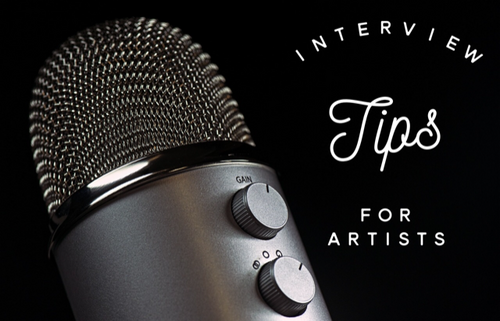By Carolyn Edlund
You’ve connected with a member of the press and gotten an interview scheduled. Congratulations! Now what?

If you are getting free publicity, careful planning will give you a chance to make the most of the opportunity Use these strategies before, during, and after the interview to maximize it’s effect.
Before the Interview
- Become familiar with the media outlet first. Who is their audience? What formats do they use? Read or watch previous interviews to see how they present.
- Know what you want to accomplish before you go in. Is it your goal to promote your newest work, an upcoming show, a release of merchandise with your licensed designs? Make a list of ways you can bring this into the conversation.
- Have some “quotable quotes” ready. It might be your unique selling opportunity, or a fascinating bit of trivia about your medium. Reporters love good quotes, so think about and prepare these before you speak.
- Be sure to have a press kit, photos of your work, videos, your artist statement or resume, or other materials as needed by the reporter to enhance the final interview piece. Articles about visual artists need photos. Will you share your finished work in a room setting, or a shot of yourself working in the studio?
- Are you being interviewed on television or radio? Do a dry run with a friend to get used to speaking about yourself so that your final interview runs more smoothly.
During the Interview
- Don’t interrupt the interviewer. Allow them to ask the full question before you respond.
- In general, keep your answers short and to the point. Avoid rambling, which can become confusing or uninteresting.
- If the reporter asks a question you don’t know the answer to, admit it. Or offer to find out for them, and supply the answer before they publish.
- Any controversial or off-the-record remarks may get included in the interview article, so be careful to keep your responses polished and professional. Be honest, friendly and approachable.
- Stay away from jargon or terms the audience won’t understand. Instead, use descriptive language so you can help the reader or listener visualize your technique and your inspiration.
- Stay aware of deadlines, and work with the reporter. Keep your appointments, get answers back to them promptly, and provide supplemental information as soon as it is needed.
After the Interview
- Use your website to share the news. Announce your interview on your blog in a post, with a link to the source. Create a “Press” page on your site if you don’t already have one. Use the publication’s logo, and headline for your article, with a link.
- Go big on social media, with shares on Facebook, Instagram, LinkedIn, Pinterest or other platforms to let your followers know, and encourage them to also share.
- Reach out to personal friends and relatives who will be thrilled to hear of this success. Ask them to share the news on social and with people they know.
- Use a link to the interview in your email signature.
- Print out any published articles to use as collateral. This establishes social proof shows that you are a great interview!
- Use your article as a reason to contact prospects. Sharing your press exposure can only help those galleries or retailers who are considering your work.
- Create an email campaign and send to your list of customers, subscribers, friends and business connections. Include a photo and a link to the article.
- Include copies of your printed interview with any promotional materials at trade shows, art fairs or other appearances. Send them to any sales reps or agents you work with.
- If your interview article is printed online, make a comment on the article thanking the reporter. You can add clarification, or answer other comments at that time.


Great stuff! Very helpful, thank you!